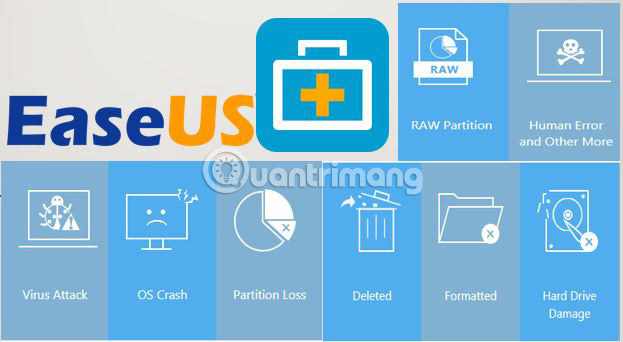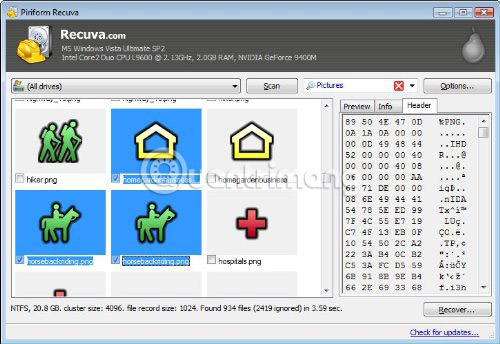How to reformat an external hard drive does not cause data loss
Most people are quite adept at keeping backups of their valuable data on an external hard drive. But what if this hard drive is broken?
This is why you are always advised to create an offsite backup (acting as a local copy), even if you have used the cloud storage service but it is too late if the hard drive Your failure before you know that advice.
Thankfully, with a few simple workarounds, you can reformat the external hard drive without losing any data on it.
Steps to reformat an external hard drive do not cause data loss
- Is this possible?
- How to reformat the drive on Windows
- How to reformat the drive on a Mac
- Why is Quick Format important?
- Do not add other files!
- Use data recovery software
- 1. Prosoft
- 2. EaseUS Data Recovery Wizard
- 3. Recuva
Is this possible?
It is not difficult to see that on technology forums, people often think 'data recovery' and 'format hard drives' are terms that cancel each other out. In fact, that's not the case.
You can completely wipe (wipe) the hard drive without losing all data on it. This process requires you to format the drive and then use the data recovery tool to 'save' the data.
The method for the format of this process will vary depending on whether you use a Windows or macOS computer. The article will include both of these platforms. Read on to find out more.
How to reformat the drive on Windows

The process of reformatting an external hard drive on Windows is very simple. For detailed implementation, please refer to the article: How to format the hard drive on Windows.Note: Select Quick Format when displaying the above window, otherwise you will lose all data.
How to reformat the drive on a Mac
MacOS does not have a Quick Format box like Windows, but users can still achieve the same results by adjusting a specific setting.
To get started, open the Finder application and select Applications from the left panel.
Scroll down to the list of applications until the Utilities folder . Open the folder and locate Disk Utility.
In the Disk Utility application , you will see the external hard drive listed in the External section on the left side of the screen. Click on the drive name.
Now, direct attention to the top of the window and click the Erase button. The operating system will prompt the user to wipe the drive.

Do not continue but click on the Security Options link . It is important to make sure that the slider is moved to the left of the scale. If the slider is not in place, users will lose some (or all) of their files. Data recovery process will not be possible.
Why is Quick Format important?
If you want to use data recovery software, users need to perform Quick Format (or equivalent option on a Mac), but why do you have to do so?
Consider files like books on bookshelves. The file system is like a directory for users to know where to store books. Perform a Quick Format operation just like throwing away portions but still keeping the books. Users cannot find books easily, but they are still there.
More technically speaking, Quick Format only deletes the file system log. It does not overwrite the entire drive with binary binary numbers. The files remain the same, but File Explorer / Finder cannot see them anymore because they do not have any information about where to find the file. The files are still there until they are overwritten with new data from the user.
Do not add other files!
At this stage, it is imperative not to write any new data to the hard drive.
As the article explains, all new data will directly overwrite old files (being hidden). And the overwrite does not take place as a file, replacing one file. If adding a new file to an external hard drive, users can damage hundreds of files that they need to access.
Now only use data recovery software.
Use data recovery software
Now it's time to switch to a data recovery application. This is a specialized software that can find files on a hard drive without a list that indicates where to find it.
Quite a number of data recovery applications have a free trial version. Sometimes, this free version is limited to a certain number of files or storage capacity. If you are trying to recover more data, users may need to spend an extra amount.
Here are 3 data recovery applications you can try:
1. Prosoft

Available on: Windows, Mac
Prosoft is a data recovery application that is available on both Windows and Mac. It can recover more than 100 different file types, recognize duplicate files among the types of files you want to recover and provide recovery versions preview, before starting the process.
The free trial allows users to see the preview, making sure it works before the user spends the purchase.
Download Prosoft (Free trial, $ 99 / 2.277.000VND for full license).
2. EaseUS Data Recovery Wizard

Available on: Windows, Mac
EaseUS Data Recovery Wizard is probably the most famous data recovery application.
Unlike Prosoft, it allows users to recover 2GB of data for free. All major file types are supported.
If you need to recover over 2GB of data, users will have to pay for the Pro version. It costs $ 69.99 (VND 1,610,000) for a lifetime license.
Refer to the article: How to recover data with Easeus Data Recovery Wizard for more details.
Download EaseUS Data Recovery Wizard (Free, $ 69.99 for Pro version).
3. Recuva

Available on: Windows
Recuva application is only for Windows. It's free to download and use, and => leave without any data limit.
The $ 19.95 Pro version (459,000VND) adds support for virtual hard drives and automatic updates.
Please refer to the article: Recover, save the deleted file completely with Recuva for details on how to do it.
Download Recuva (Free, $ 19.95 for Pro version).
As the article mentions at the beginning, all of these problems can be easily avoided if you create multiple backups of your data.
At the very least, you should keep a local backup and a copy on the cloud. Having a backup on a NAS drive, with a cloud storage provider, on an external hard drive and with a dedicated backup application provider is an ideal one.
Wish you find the right solution!
You should read it
- 7 best external hard drives
- What is a hard drive? There are several types?
- How to format a hard drive into NTFS in Linux
- How to Write to an External Hard Drive on Mac OS X
- How to identify hard drive failure, hard drive failure, bad hard drive on Windows
- Know about bad sectors on your hard drive
- How to fix an external hard drive error is not displayed on the Mac
- How to format an external hard drive to FAT32?
May be interested
- Advice on buying an external hard drive
 in fact, today's portable hard drives are quite popular with mobility as well as increasing memory capacity. however, the purchase of this product also needs to be carefully considered and depends largely on the need to use the data as well as the equipment that the user is in order to avoid the absence of it, but if so it's too much
in fact, today's portable hard drives are quite popular with mobility as well as increasing memory capacity. however, the purchase of this product also needs to be carefully considered and depends largely on the need to use the data as well as the equipment that the user is in order to avoid the absence of it, but if so it's too much - Everything you need to know about external hard drives Xbox One
 if you've owned xbox one for a while, chances are you'll run out of storage. most xbox one models come with either a 500gb or 1tb drive, but this is not a lot.
if you've owned xbox one for a while, chances are you'll run out of storage. most xbox one models come with either a 500gb or 1tb drive, but this is not a lot. - Instructions on how to set a password for the drive on Windows 10
 password lock for external hard drive is one of the ways to protect data stored in hard drive. follow the following article to know how to set a password for an external hard drive
password lock for external hard drive is one of the ways to protect data stored in hard drive. follow the following article to know how to set a password for an external hard drive - What is a hard drive? There are several types?
 today most types of computers are large and small need to use hard drives, this is an extremely important part for computers, it has the ability to store all personal data and they are always accessed regularly. .
today most types of computers are large and small need to use hard drives, this is an extremely important part for computers, it has the ability to store all personal data and they are always accessed regularly. . - External hard drive: savior of data
 there has been some progress with external hard drives via usb ports in recent times: capacities up to several hundred gigabytes, can automatically backup data, run stably with machines with low power capacity. this is the ideal storage medium for work
there has been some progress with external hard drives via usb ports in recent times: capacities up to several hundred gigabytes, can automatically backup data, run stably with machines with low power capacity. this is the ideal storage medium for work - Causes and ways to fix external hard drive slow on Windows 10
 when plugging an external hard drive into a computer and finding it slower than before? whether your computer is infected with a virus or a certain setting in windows 10 makes everything slow or maybe just a simple problem like a broken cable. this article will find out the cause and offer a way to fix the external hard drive slow on windows 10.
when plugging an external hard drive into a computer and finding it slower than before? whether your computer is infected with a virus or a certain setting in windows 10 makes everything slow or maybe just a simple problem like a broken cable. this article will find out the cause and offer a way to fix the external hard drive slow on windows 10. - How to Reformat Windows 7
 you may have a pc that has been infected with viruses or spyware, or you may have a blank hard drive you need to set up. in either case, you may need to reformat your hard drive. you can reformat a pc with windows 7 by reinstalling windows...
you may have a pc that has been infected with viruses or spyware, or you may have a blank hard drive you need to set up. in either case, you may need to reformat your hard drive. you can reformat a pc with windows 7 by reinstalling windows... - How to use an external hard drive with a Chromebook
 sometimes you may need to transfer files by moving the flash drive or have sensitive files that you don't want to store online. today's article will guide you how to use your flash drive or external hard drive with your chromebook.
sometimes you may need to transfer files by moving the flash drive or have sensitive files that you don't want to store online. today's article will guide you how to use your flash drive or external hard drive with your chromebook. - 5 ways to check hard drive effectively to help periodically check the hard drive
 the following ways will help you check your hard drive, assess the current status of the hard drive on the computer you are using. since then, there have been early instabilities to find out timely measures to avoid hard drive failure and data loss.
the following ways will help you check your hard drive, assess the current status of the hard drive on the computer you are using. since then, there have been early instabilities to find out timely measures to avoid hard drive failure and data loss. - 5 ways to use iPhone as an external hard drive
 it would be great if you could use your phone to store data to take with you. luckily, you can do that. here are 6 ways to use your iphone as an external hard drive.
it would be great if you could use your phone to store data to take with you. luckily, you can do that. here are 6 ways to use your iphone as an external hard drive.










 How to use Auslogics Disk Defrag to defragment your hard drive
How to use Auslogics Disk Defrag to defragment your hard drive How to update and reinstall Realtek HD Audio Manager
How to update and reinstall Realtek HD Audio Manager Summary of driver error codes on Windows and how to fix them (Part 1)
Summary of driver error codes on Windows and how to fix them (Part 1) 10 shortcuts that users often accidentally hit
10 shortcuts that users often accidentally hit How to fix KERNEL SECURITY CHECK ERROR in Windows
How to fix KERNEL SECURITY CHECK ERROR in Windows Fix UNMOUNTABLE_BOOT_VOLUME error in Windows
Fix UNMOUNTABLE_BOOT_VOLUME error in Windows